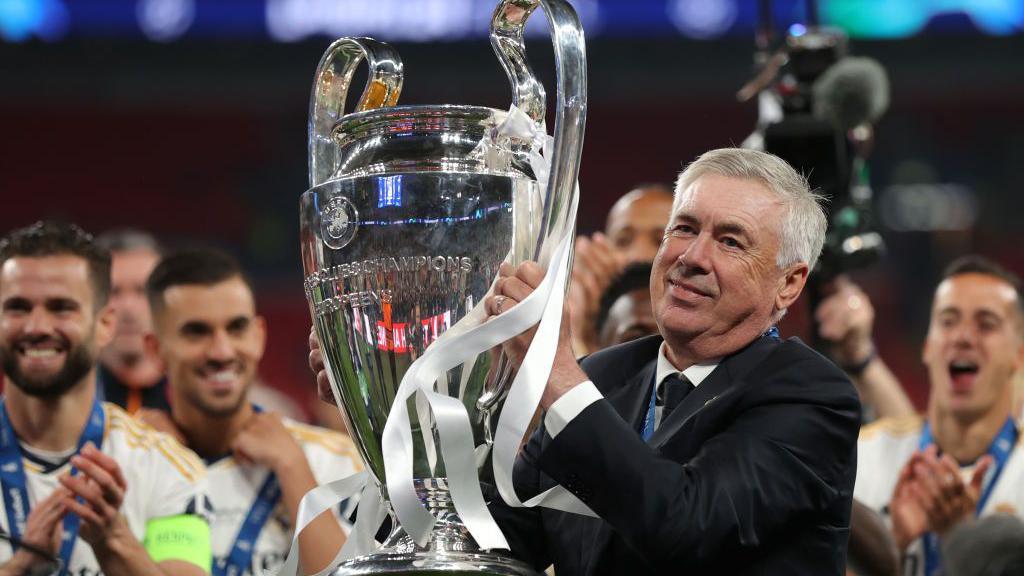 BBC Sport
BBC Sport-
9 May 2025
In what has been the worst kept secret in the footballing world, Xabi Alonso has been announced as Real Madrid’s new manager.
After announcing this month that he would leave Bayer Leverkusen this summer, the former Real and Liverpool midfielder has signed a three-year deal at the Bernabeu as Carlo Ancelotti’s successor.
It is an inevitable, if bittersweet, conclusion to Ancelotti’s second spell at Madrid.
So finally, we have the much expected transition, with the Italian legend stepping aside to take charge of Brazil and the young pretender returning to the Bernabeu.
This changing of the guard, from the club’s most decorated coach to a rising star in management, is symbolic. It marks the end of an era and the beginning of a fascinating new one.
A situation facilitated by the innate reasonableness of Bayer Leverkusen who, true to their word, stood by the gentlemen’s agreement between coach and club that they would not stand in Alonso’s way should he receive an offer he could not refuse.
To play this video you need to enable JavaScript in your browser.
This video can not be played
Alonso’s task at Real Madrid is enormous
Madrid are now preparing for a future led by their former midfielder, with president Florentino Perez viewing Alonso as the long-term answer.
The 43-year-old’s success at Leverkusen has elevated his profile, and Real believe he possesses the tactical sharpness and emotional intelligence to lead a generational transition.
Last year he led Leverkusen to a Bundesliga title, without losing a game, and the German Cup in his first full season as a senior club manager.
But the task Alonso faces at Real is enormous.
He will inherit a squad in flux, needing to balance Kylian Mbappe’s presence and Vinicius Jr’s leadership, with the Brazilian about to sign a longer contract.
Alonso will also need to integrate youngsters like Endrick and Arda Guler, phasing out the old guard and delivering trophies immediately.
He will also need to navigate a boardroom that wants influence, a fan base that demands instant success and a media environment that will hold him to impossible standards from day one.
Alonso has the tactical credentials, but this is Madrid where talent alone does not guarantee survival.
After winning La Liga and the Champions League last season, a campaign without a trophy serves to justify the club’s decision to end the Ancelotti era.
You cannot underestimate the enormity of his contribution to the club, though.
Fifteen trophies – more than any manager in the club’s history – in two eras of success, steadiness and quiet revolution.
Ancelotti brought dignity and calm to chaos. He won with style, without needing to shout, and restored order when the club was on the edge.
Fractures grew and tensions became constant
When Ancelotti returned to Madrid in 2021 following Zinedine Zidane’s unexpected resignation, the club were drifting.
The stadium redevelopment was mid-construction, the squad was thin and there was a palpable lack of direction. Yet Ancelotti brought calm, clarity, credibility – and a remarkable resurgence.
In his first season back, after the departure of key players Sergio Ramos and Raphael Varane, they secured a La Liga and Champions League double, plus the Spanish Supercup, an achievement few believed possible given the structural limitations.
Key areas of the squad remained unaddressed because of financial pressure caused by escalating stadium costs. But through man-management, tactical pragmatism and the brilliance of individuals, Madrid triumphed.
However, that same success planted the seeds of future discord as the squad was not improved dramatically and players who left – especially Toni Kroos – were not replaced adequately.
When Mbappe finally arrived from Paris St-Germain last summer, Perez believed the team would take another leap forward.
But fractures had already begun to appear, not just tactically but inside the changing room.
Behind closed doors, disagreements surfaced over physical preparation and discipline, and Perez, always deeply involved, became more vocal in his frustration.
From the directors’ box came disdainful comments, on the lack of defensive work by the main stars, despite meetings between the manager and them to turn things around, and Ancelotti’s management of emerging talents.
Questions were raised over the cautious handling of Guler, and doubts cast over whether forward Endrick would thrive under Ancelotti’s approach.
The tension, though never explosive, became constant. By October the club leadership felt Ancelotti was not addressing the issues and the idea of Madrid taking a new direction started to take root.
One of the hardest changing rooms Ancelotti has had to manage
On the pitch, the team lost coherence. The dressing room – once unified by Ancelotti’s steady hand – began to fragment. Key players stopped listening to him, while others grew weary of his hands-off approach.
Perhaps most destabilising was the rivalry between Vinicius and Mbappe. Both wanted to be the face of the team.
Mbappe preferred to play centrally, but Vinicius believed he had earned top billing. There was no open conflict, but the on-pitch dynamic spoke volumes. In critical moments, they did not look for each other. The tension was visible to staff and team-mates alike.
Ancelotti, usually the master of ego management, struggled and admitted privately it was one of the hardest changing rooms to manage in his career.
On some occasions, pre-match media briefings became short and irritable, with Ancelotti feeling he was not getting the club support he thought he deserved.
He had asked for right-back Kyle Walker in January to cover for long-term injuries to Dani Carvajal and Eder Militao, but the request was rejected.
Outwardly, the 65-year-old remained respectful. He repeated the same line: “I will stay at Madrid until the club no longer wants me.”
To fans, that echoed loyalty. But to Perez, it sounded like pressure.
Now the Brazil job stands as Ancelotti’s next frontier.

